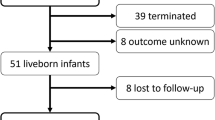Abstract
Associated congenital anomalies have emerged as the most significant prognostic factor in babies born with oesophageal atresia and/or tracheo-oesophageal fistula (OA-TOF). The most frequently encountered groups of anomalies are cardiovascular (CV) and gastrointestinal, the former being more significant from a prognostic point of view. Some, such as a right-sided aortic arch (RAA), vascular ring, or major heart defects, may alter the timing and surgical approach for the repair of OA-TOF or adversely affect the prognosis. The rat fetal OA model induced by adriamycin (Adr) has been described previously. In the present experiments, information was sought regarding the incidence and type of CV abnormalities in fetal rats obtained from Adr-treated dams. OA-TOF was induced in 24 of 36 fetal rats from Adr-treated dams. DV abnormalities were found in 18 (75%) OA-TOF fetuses and 10 (83%) Adr-treated fetuses without OA-TOF. The difference was not significant (P > 0.05). The most frequently found anomalies were ventricular and atrial septal defects. A RAA was present in 8/36 fetuses and a double aortic arch in 2/36. A patent ductus arteriosus was present in all treated fetuses compared with two-thirds of controls. The findings in the present study emphasise the importance of CV anomalies in association with OA, and reinforce the value of the Adr-induced rat fetal OA model by adding to our knowledge of the basic embryogenesis of both OA and CV anomalies.
Similar content being viewed by others
References
Beasley SW (1991) Embryology. In: Beasley SW, Myers NA, Auldist AW (eds) Oesophageal atresia. Chapman & Hall, London, pp 31–42
Beasley SW, Myers NA (1991) Trends in mortality. In: Beasley SW, Myers NA, Auldist AW (eds) Oesophageal atresia. Chapman & Hall, London, pp 361–367
Chittmittrapap S, Spitz L, Kiely EM, et al (1989) Oesophageal atresia and associated anomalies. Arch Dis Child 64: 364–368
Czeizel A, Ludanyi I (1985) An aetiological study of the VACTERL-association. Eur J Pediatr 144: 331–337
Diez-Pardo JA, Qi BQ, Tovar JA (1996) A new rodent experimental model of esophageal atresia and tracheoesophageal fistula: preliminary report. J Pediatr Surg 31: 498–502
Ein SH, Shandling B, Wesson D, et al (1989) Esophageal atresia with distal tracheoesophageal fistula: associated anomalies and prognosis in the 1980s. J Pediatr Surg 24: 1055–1059
German JC, Mahour GH, Woolley MM (1976) Esophageal atresia and associated anomalies. J Pediatr Surg 11: 299–306
Greenwood RD, Rosenthal A (1976) Cardiovascular malformations associated with tracheoesophageal fistula and esophageal atresia. Pediatrics 57 (1): 87–90
Harrison MR, Hanson BA, Mahour H, et al (1977) The significance of right aortic arch in repair of esophageal atresia and tracheoesophageal fistula. J Pediatr Surg 12: 861–869
Hartenberg MA, Salzberg AM, Krummel TM, et al (1989) Double aortic arch associated with esophageal atresia and tracheoesophageal fistula. J Pediatr Surg 24: 488–490
Knight L, Edwards JE (1974) Right aortic arch types and associated cardiac anomalies. Circulation 50: 1047–1051
Mee RBB (1991) Congenital heart disease. In: Beasley SW, Myers NA, Auldist AW (eds) Oesophageal atresia. Chapman & Hall, London, pp 229–240
Mellins RB, Blumenthal S (1964) Cardiovascular anomalies and esophageal atresia. Am J Dis Child 107: 96–100
Myers NA (1974) Oesophageal atresia: the epitome of modern surgery. Ann Roy Coll Surg Eng 54: 277
Myers NA (1989) Doctoral thesis, University of Melbourne, Vol, I: 7
Quan L, Smith DW (1973) The VATER association. J Pediatr 82: 104–107
Sissman NJ (1983) Anomalies of the aortic arch complex. In: Adams FH, Emmanouilides GC (eds) Moss' heart disease in infants, children and adolescents, 3rd edn. Williams and Wilkins, Baltimore London, pp 199–214
Triglia JM, Guys JM, Louis-Borrione C (1944) Tracheomalacia caused by arterial compression in esophageal atresia. Ann Otol Rhinol Laryngol 103: 516–521
Weber TR, Smith W Grosfeld JL (1980) Surgical experience in infants with the VATER association. J Pediatr Surg 15: 849–854
Weigel W Kaufmann HJ (1976) The frequency and types of other congenital anomalies in association with tracheoesophageal malformations. Clin Pediatr 15 (9): 819–834
Author information
Authors and Affiliations
Rights and permissions
About this article
Cite this article
Qi, B.Q., Merci, J., Farmer, P. et al. Cardiovascular malformations in rat fetuses with oesophageal atresia and tracheo-oesophageal fistula induced by adriamycin. Pediatr Surg Int 12, 556–564 (1997). https://doi.org/10.1007/BF01371899
Issue Date:
DOI: https://doi.org/10.1007/BF01371899




